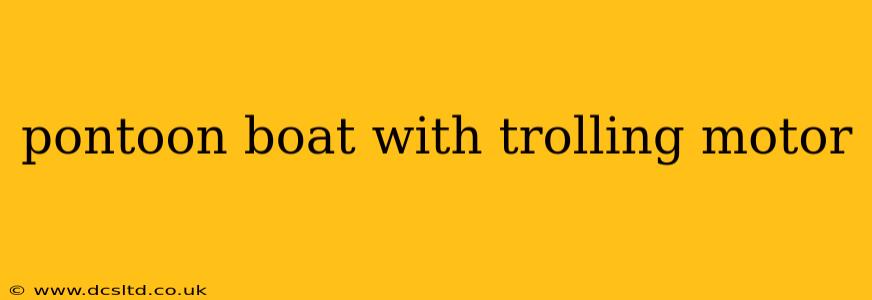Pontoon boats, known for their stability and spaciousness, are increasingly popular for leisurely cruising and fishing. Adding a trolling motor enhances their versatility, making them ideal for navigating shallow waters, fishing quietly, and maximizing enjoyment on the water. This guide explores the benefits, considerations, and practical aspects of using a trolling motor on your pontoon boat.
What are the Benefits of a Trolling Motor on a Pontoon Boat?
A trolling motor offers several advantages when paired with a pontoon boat:
-
Precise Control in Shallow Waters: Pontoons, with their flat bottom, can struggle in shallow areas. A trolling motor provides the precise control needed to navigate these tricky spots without running aground. You can effortlessly maneuver through lily pads, weed beds, and other shallow-water obstacles.
-
Quiet Fishing: The quiet operation of a trolling motor is crucial for successful fishing. It minimizes noise and vibration, allowing you to approach fish without spooking them. This is especially beneficial for attracting sensitive species.
-
Improved Fuel Efficiency: Using a trolling motor significantly reduces fuel consumption compared to using your main outboard motor. This can translate to substantial savings on fuel costs, especially during extended fishing trips.
-
Enhanced Maneuverability: A trolling motor provides excellent maneuverability, particularly in tight spaces like docks or crowded marinas. You'll find it much easier to dock and navigate in confined areas.
-
Extended Range: Combining your main outboard motor with a trolling motor extends your boat's range significantly. You can use the trolling motor for quiet fishing or slow cruising and reserve your main engine for longer distances.
What Type of Trolling Motor is Best for a Pontoon Boat?
Choosing the right trolling motor depends on several factors:
-
Pontoon Size and Weight: Larger pontoons require more powerful motors. Consider the weight of your pontoon and the load it typically carries when selecting the thrust (measured in pounds).
-
Fishing Style: If you primarily fish in shallow water and need precise control, a bow-mounted trolling motor is ideal. For broader maneuverability, a transom-mounted motor might be preferable.
-
Battery Life: Longer fishing trips require longer battery life. Consider the amp-hour rating (Ah) of the battery to ensure sufficient power for your needs. Many anglers opt for multiple batteries for extended use.
-
Shaft Length: The shaft length needs to be appropriate for your pontoon's height and water depth. Measure the distance from the mounting point to the waterline and select a shaft that's long enough to clear the pontoons even when fully submerged.
How Do I Install a Trolling Motor on My Pontoon Boat?
Installation can vary depending on the type of motor (bow-mount or transom-mount). Bow-mount motors generally require more complex installation involving mounting brackets and wiring. Transom-mount motors are typically easier to install, attaching directly to the transom of the pontoon. Consult your trolling motor's instruction manual for detailed installation guidance. If you lack experience, seek professional assistance from a marine mechanic.
What Size Trolling Motor Do I Need for My Pontoon Boat?
There's no one-size-fits-all answer. The ideal size depends heavily on the size and weight of your pontoon. A good rule of thumb is to choose a trolling motor with sufficient thrust to comfortably handle your boat's weight, passengers, and gear, even in challenging conditions. Many manufacturers offer sizing guides based on boat length and weight – consult these resources or seek advice from a reputable marine retailer.
How Much Does a Trolling Motor Cost?
The cost of a trolling motor varies widely depending on the brand, features, and power output. Expect to pay anywhere from a few hundred dollars for a basic model to over a thousand dollars for high-end, feature-rich trolling motors with GPS capabilities and advanced control systems.
Can I Use a Trolling Motor in Saltwater?
Yes, many trolling motors are designed for saltwater use and feature corrosion-resistant materials. However, it's crucial to choose a motor specifically designed for saltwater environments to ensure longevity and prevent damage from salt corrosion. Regular rinsing with freshwater after each saltwater use is highly recommended.
By carefully considering these factors, you can select and install a trolling motor that perfectly complements your pontoon boat, enhancing your enjoyment and expanding your fishing opportunities. Remember to always prioritize safety and consult with professionals when needed.
